09 Apr Don’t be a victim of a poor Landscape Lighting installation !
by Mike Gambino
I’ve been designing, installing and maintaining landscape lighting systems for 21 years. I cannot count how many homeowners I’ve come upon who have been the victim of a poor landscape lighting installation. It usually goes hand in hand with the use of materials of low quality , performance and durability.
There are so many ways an unsuspecting homeowner can get stuck with an under performing, troublesome landscape lighting system. In other words there are so many ways an installer can cut the quality without it being detected until its too late.
The first red flag should arise even before the service provider is hired.
If the pitch centers around how the job can be done cheaper because the wire can be thrown in the same trenches as the sprinkler pipes then you should be suspicious of that.
Yes there will be instances where sprinkler pipes and low voltage lighting cable can practically be installed together at the same time resulting in decreased labor cost. But for the most part lighting fixtures will be located apart from sprinkler equipment and a fair amount of additional digging will be required.
“We will include the lighting as a loss leader if you give us the whole landscape project”- In this instance how good of a system do you expect the contractor will install if he is not making any money for his efforts?
Do you think that much consideration will be made as to placement of fixtures and transformers ?
I doubt it very much.
Some of the most common ways to a cheap lighting system
Lack of investment in proper truck and tools by the installer- Using a truck that has not been outfitted with the proper tools,  equipment and materials to design and install a low voltage landscape lighting system is a way that cheaper installers save money on overhead. The lacking of a dedicated service vehicle is also a way to work very ineffectively and inefficiently. Not having the proper parts during an installation can be very frustrating and costly. Having to run to the supply house for a screw is also a chore and it will cost someone money in gas and lost time. Not having the proper tools to burrow under a concrete path or drill through a wall can also limit the flexibility of the design. It’s almost like eating spaghetti with a spoon
equipment and materials to design and install a low voltage landscape lighting system is a way that cheaper installers save money on overhead. The lacking of a dedicated service vehicle is also a way to work very ineffectively and inefficiently. Not having the proper parts during an installation can be very frustrating and costly. Having to run to the supply house for a screw is also a chore and it will cost someone money in gas and lost time. Not having the proper tools to burrow under a concrete path or drill through a wall can also limit the flexibility of the design. It’s almost like eating spaghetti with a spoon
 Inexperience– Is very costly to the homeowner because in essence the installer is using your property as learning grounds. Inexperienced lighters who land jobs usually under price them because they do not understand their true costs. In addition do you really want someone experimenting with the electrical system of your home? Do your due diligence and View a prospective lighter’s previous work and check out their projects. Start by viewing their website photos. If you are still not sure then insist on physically viewing some projects after dark.
Inexperience– Is very costly to the homeowner because in essence the installer is using your property as learning grounds. Inexperienced lighters who land jobs usually under price them because they do not understand their true costs. In addition do you really want someone experimenting with the electrical system of your home? Do your due diligence and View a prospective lighter’s previous work and check out their projects. Start by viewing their website photos. If you are still not sure then insist on physically viewing some projects after dark.
Cable– Another areas where cost savings can occur is in the choice of cable size and quantity. A system should be built to have a reasonable amount of expandability without the homeowner incurring major costs to do so. If the installer uses under sized cable from the start and or attaches too many fixtures to it. Then not only will performance suffer (ie- brightness and effectiveness) but the system will have been built with no room for adding any additional fixtures in a cost effective manor as new main cables will need to be brought from the transformer to supply additional fixture/s as desired. Choosing appropriate size cable and the design and engineering of low voltage system wiring is of paramount importance. Rarely if ever will a novice or part-time installer even understand or have mastered this most important aspect of a landscape lighting system.
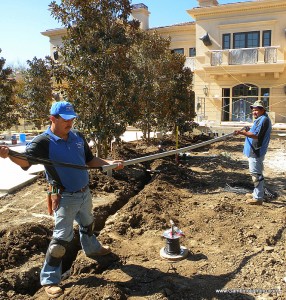 Burying of Cable- Is the most labor intensive part of a lighting installation. The cheap bid may lay cable on the top of the ground exposed and vulnerable without burying it. Or scratch it superficially into the soil where it will inevitably end up outside the ground in short time. Or cover it in mulch or gravel which will also only be temporary where it will become exposed. Digging takes labor and labor costs money. Cables should be buried to a minimum 6″ depth and should at the very least be installed inside rigid PVC conduit where they are able to be dug up and damaged. The best systems are installed completely inside rigid PVC conduit buried to a minimum of 6 inches below the ground. Deeper in areas where annual color or other planting occurs on a regular basis.
Burying of Cable- Is the most labor intensive part of a lighting installation. The cheap bid may lay cable on the top of the ground exposed and vulnerable without burying it. Or scratch it superficially into the soil where it will inevitably end up outside the ground in short time. Or cover it in mulch or gravel which will also only be temporary where it will become exposed. Digging takes labor and labor costs money. Cables should be buried to a minimum 6″ depth and should at the very least be installed inside rigid PVC conduit where they are able to be dug up and damaged. The best systems are installed completely inside rigid PVC conduit buried to a minimum of 6 inches below the ground. Deeper in areas where annual color or other planting occurs on a regular basis.
Transformers– A common area where significant cost savings, at the detriment of the homeowner, can occur is in the selection of 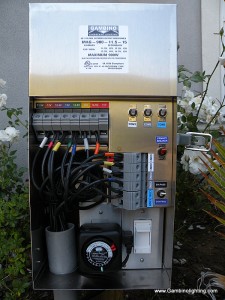 transformers for the project. A cheap transformer lacks the ability to maintain consistent and proper voltage output under load. If they are to be installed out of doors then the transformer enclosure should always be built of stainless steel to ensure longevity. They should be of the multiple-tap variety (15V maximum output) and UL listed for the application which is low voltage garden lighting. At the very least the transformer should have built in circuit breaker protection for the low voltage wiring and preferably in addition high voltage protection as well. The transformer should also have sturdy terminal connections to securely and safely connect the wires that provide low voltage power to the fixtures. A top of the line Gambino high performance high output landscape lighting transformer is shown to the right.
transformers for the project. A cheap transformer lacks the ability to maintain consistent and proper voltage output under load. If they are to be installed out of doors then the transformer enclosure should always be built of stainless steel to ensure longevity. They should be of the multiple-tap variety (15V maximum output) and UL listed for the application which is low voltage garden lighting. At the very least the transformer should have built in circuit breaker protection for the low voltage wiring and preferably in addition high voltage protection as well. The transformer should also have sturdy terminal connections to securely and safely connect the wires that provide low voltage power to the fixtures. A top of the line Gambino high performance high output landscape lighting transformer is shown to the right.
Connections– This is also an area where an installer can skimp and probably get away with it until they go bad since they are typically buried under the ground.
under the ground. 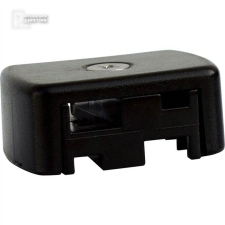 Wire nuts designed to go inside waterproof junction boxes should never be used where they will come into contact with the ground or get moist. They also should not be used where they could potentially be pulled and loosened or disconnected. Therefore these types of connections should never be used in a landscape lighting system and buried directly in the ground. So called quick connect type connectors should also never be used in a professionally installed system as they are not weatherproof, have a tendency to go bad over time and are generally unreliable and troublesome. The worse connection of all is the loose connection which can cause intermittent operation of part or entire system and in the most severe case can result in fire from the generation of excess heat.
Wire nuts designed to go inside waterproof junction boxes should never be used where they will come into contact with the ground or get moist. They also should not be used where they could potentially be pulled and loosened or disconnected. Therefore these types of connections should never be used in a landscape lighting system and buried directly in the ground. So called quick connect type connectors should also never be used in a professionally installed system as they are not weatherproof, have a tendency to go bad over time and are generally unreliable and troublesome. The worse connection of all is the loose connection which can cause intermittent operation of part or entire system and in the most severe case can result in fire from the generation of excess heat.
 Fixtures- Painted steel or aluminum fixtures like the one in the photo to the left are not the best choice for ground contact lighting fixtures. The best fixtures are constructed from copper brass and stainless steel. However there are different grades of material used so not all fixtures are created equal regardless of the fact that it may appear that they are constructed of the same type of metal. Ferrous (non rusting metals) that are poured or injected into a mold are called cast or castings. Generally speaking they are of better quality and more durable than spinnings which are sometimes made from thinner metals but this is not always the case. Therefore I always recommend that a property owner be able to physically handle and inspect fixtures before hiring a service provider to be sure exactly what the quality of the materials are they are getting. The other notable difference between designer quality fixtures and a consumer quality ones will be the fixtures ability to shield glare and accept optional optical lenses to change color, shape and or dimension of lighting effect.
Fixtures- Painted steel or aluminum fixtures like the one in the photo to the left are not the best choice for ground contact lighting fixtures. The best fixtures are constructed from copper brass and stainless steel. However there are different grades of material used so not all fixtures are created equal regardless of the fact that it may appear that they are constructed of the same type of metal. Ferrous (non rusting metals) that are poured or injected into a mold are called cast or castings. Generally speaking they are of better quality and more durable than spinnings which are sometimes made from thinner metals but this is not always the case. Therefore I always recommend that a property owner be able to physically handle and inspect fixtures before hiring a service provider to be sure exactly what the quality of the materials are they are getting. The other notable difference between designer quality fixtures and a consumer quality ones will be the fixtures ability to shield glare and accept optional optical lenses to change color, shape and or dimension of lighting effect.
Lamps- Also known as light bulbs. Here is an area where much money again is often saved by the cheap bid at the expense of the 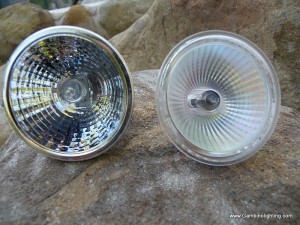 unsuspecting homeowner. No name or home improvement store brands do not compare with designer quality constant color precise lamps available to trade professionals who care about their craft. Cheap bulbs not only don’t last but break down and diminish in light output and color in a very short time totally destroying the effectiveness of your lighting system. It is the lamp or light bulb itself with the proper voltage applied to it that does the lighting and provides the affects. Cheap bulbs whether they be LED or halogen of unknown and unproven origin should never be used in a quality lighting system.
unsuspecting homeowner. No name or home improvement store brands do not compare with designer quality constant color precise lamps available to trade professionals who care about their craft. Cheap bulbs not only don’t last but break down and diminish in light output and color in a very short time totally destroying the effectiveness of your lighting system. It is the lamp or light bulb itself with the proper voltage applied to it that does the lighting and provides the affects. Cheap bulbs whether they be LED or halogen of unknown and unproven origin should never be used in a quality lighting system.
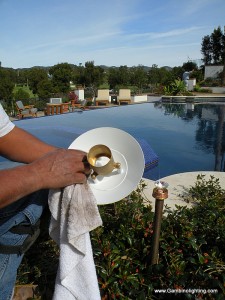 Maintenance and after care plan- If your installer doesn’t offer one then you can expect that they are not going to be around when the need for service arises. And no matter how good the quality of the system is it will need regular maintenance and the occasional unexpected or emergency repair (usually before a big party). Stuff happens and its nice to know that the original installer will be prepared and available when you need them.
Maintenance and after care plan- If your installer doesn’t offer one then you can expect that they are not going to be around when the need for service arises. And no matter how good the quality of the system is it will need regular maintenance and the occasional unexpected or emergency repair (usually before a big party). Stuff happens and its nice to know that the original installer will be prepared and available when you need them.
So there are some of the ways the low bid can be the low bid. As they say there is a reason for everything and you get what you pay for. Hopefully you will be better informed and will not fall victim after reading this article.
“If you think it’s expensive to hire a professional to do the job, wait until you hire an amateur.”





No Comments